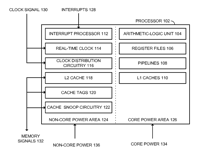
The US Patent and Trademark Office has recently published two patent applications from Apple that reveal that the company is spreading its R&D wings a bit. The patents, pointed out by MacNN, concern some basic semiconductor chip technology, including power saving and chip testing techniques.
One patent application describes a method for removing heat from a semiconductor while taking measurements by using a liquid metal interface between the semiconductor and a "heat removal device." Using liquid metal is an improvement on current methods using a silicone paste, for instance, and makes testing bare, unpackaged chips more practical. This testing is critical as the frequency of other chips in a system are increased with higher bus speeds.
The other (and more interesting) patent application describes a way to add significant power reductions in idle CPUs by cutting voltage to instruction processing areas of a CPU that are not in use. Current methods to reduce power rely on reducing the clock speed or halting clock signals altogether, as the switching of the circuits inside a processor draw more and more power as the frequency increases. However, static power is still wasted due to leakage currents, and these leakage currents increase as chip use smaller and smaller processes (think 45 or even 32 nanometers). The method described here can either reduce the voltage supplied to an idle processing unit to a minimum threshold to maintain state, or could save the state of the processing unit to other area of the chip and cut the voltage completely. Since different parts of a processor can often sit idle, significant power reduction is possible.
Apple is in a pretty good financial position as of late, and earlier this year, Morgan Stanley analyst Kathryn Huberty had noted Apple was increasing R&D spending about 32 percent every quarter throughout 2007. Though such basic science research doesn't always apply directly to a particular product, such tech can often lead the way to improving current products or making new ones possible. Combined with the lower-power know-how of PA Semi engineers, Apple could be rolling significant new power-saving innovations into, say, next-generation super-thin laptops or mobile communication devices.
reader comments